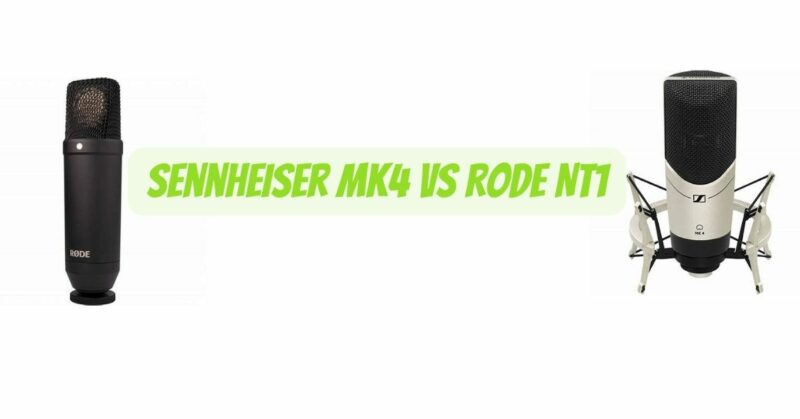When it comes to capturing studio-quality audio, a reliable and versatile condenser microphone is essential. In this article, we will compare two renowned studio microphones: the Sennheiser MK4 and the Rode NT1. Both microphones are highly regarded in the industry for their exceptional sound quality, build construction, and versatility. By examining their design, sound characteristics, features, and applications, we aim to help you make an informed decision about which microphone best suits your recording needs.
Design and Build Quality:
The Sennheiser MK4 and the Rode NT1 both exhibit solid build quality and attention to detail in their design.
The MK4 features a sleek and elegant design with a sturdy metal housing. It has a large gold-sputtered diaphragm that contributes to its accurate and detailed sound reproduction. The MK4’s design is straightforward and professional, with a cardioid polar pattern that focuses on capturing sound from the front while minimizing off-axis noise. It also includes a robust internal shock mount that helps reduce unwanted vibrations and handling noise.
On the other hand, the Rode NT1 showcases a more unique and modern design. It features a matte black finish and a large-diaphragm condenser capsule. The NT1’s body is made of high-quality stainless steel, which not only enhances its durability but also helps minimize resonance and unwanted noise. The microphone’s design includes an internal Rycote Lyre capsule suspension system, further isolating it from external vibrations and handling noise.
Sound Characteristics:
Both the Sennheiser MK4 and the Rode NT1 offer exceptional sound quality, but they do have some differences in their sonic characteristics.
The MK4 is known for its transparent and accurate sound reproduction. It captures vocals and instruments with excellent detail and clarity. The MK4 has a balanced frequency response, which lends itself well to a wide range of recording applications. Its precise transient response and low self-noise make it ideal for capturing vocals, acoustic instruments, and even percussion with precision and fidelity.
The NT1, on the other hand, offers a slightly warmer and smoother sound signature. It has a detailed high-frequency response and a balanced midrange, resulting in a pleasing and well-rounded sound. The NT1’s extended dynamic range and low self-noise level make it suitable for recording a variety of sources, from vocals and acoustic instruments to electric guitars and drums.
Features and Functionality:
Both the MK4 and the NT1 come with features that enhance their functionality and usability.
The MK4 is a straightforward microphone with a fixed cardioid polar pattern. It is designed for simplicity and ease of use, making it suitable for both professionals and beginners. The MK4 can handle high sound pressure levels, allowing it to capture loud sources without distortion. It requires 48V phantom power, which is standard in most professional audio interfaces and preamps.
The NT1, similarly, features a fixed cardioid polar pattern, providing focused sound capture and effective rejection of off-axis noise. It also has a high maximum SPL handling capability, making it suitable for recording loud sources. The NT1 boasts a remarkably low self-noise level, which ensures clean and noise-free recordings, even in quieter passages. Additionally, the NT1 package includes a shock mount and a pop filter, offering added value and convenience to the user.
Applications and Versatility:
Both the Sennheiser MK4 and the Rode NT1 find applications in various recording scenarios.
The MK4’s transparent sound reproduction and accurate transient response make it an excellent choice for capturing vocals, acoustic instruments, and studio recordings that require precision and clarity. Its versatility allows it to excel in professional studio environments, home studios, and broadcast applications.
The NT1’s warm and smooth sound, coupled with its low self-noise, makes it suitable for a wide range of recording applications. It performs exceptionally well in vocal recording, capturing nuances and details with a natural and pleasing tonality. The NT1 is also well-suited for acoustic instruments, voiceover work, and even podcasting.
Price and Value:
Consideration of the price and value of these microphones is crucial in making a well-informed decision. The Sennheiser MK4 is generally positioned as a higher-end microphone and is priced accordingly. It is an investment for professionals and enthusiasts who prioritize exceptional sound quality and reliability. The MK4’s transparent sound reproduction and durable build construction make it a valuable asset in any recording setup.
On the other hand, the Rode NT1 offers excellent value for its price. It provides impressive sound quality, versatile applications, and includes additional accessories such as a shock mount and pop filter. The NT1’s affordability makes it an attractive option for musicians, home studio owners, and content creators who seek a high-quality microphone without breaking the bank.
Conclusion:
In the Sennheiser MK4 vs. Rode NT1 comparison, both microphones excel in delivering exceptional sound quality, build construction, and versatility. The MK4 impresses with its transparent sound reproduction, accurate transient response, and professional design. It is a reliable choice for professionals who require precise and detailed recordings.
The NT1 stands out with its warm and smooth sound signature, low self-noise, and modern design. It offers versatility and value, making it a popular choice among musicians, home studio owners, and podcasters.
When making your decision, consider your specific recording needs, budget, and preferences in terms of design, sound characteristics, and features. Both the Sennheiser MK4 and the Rode NT1 are reputable microphones that can elevate your audio recordings to a professional level.

